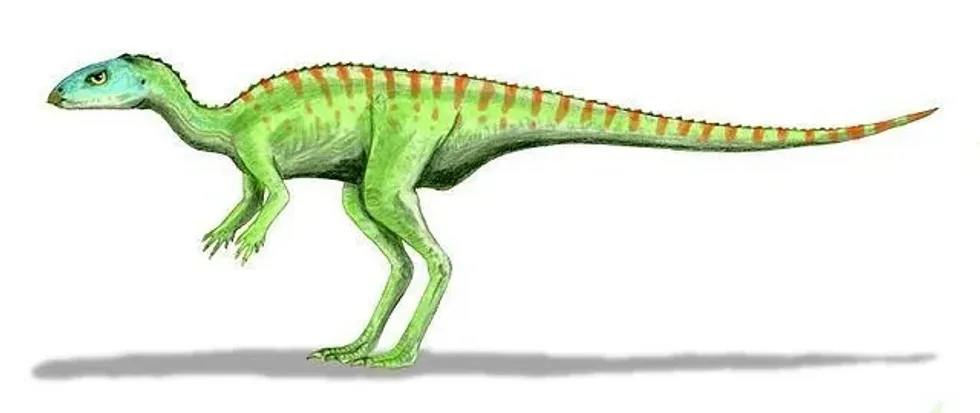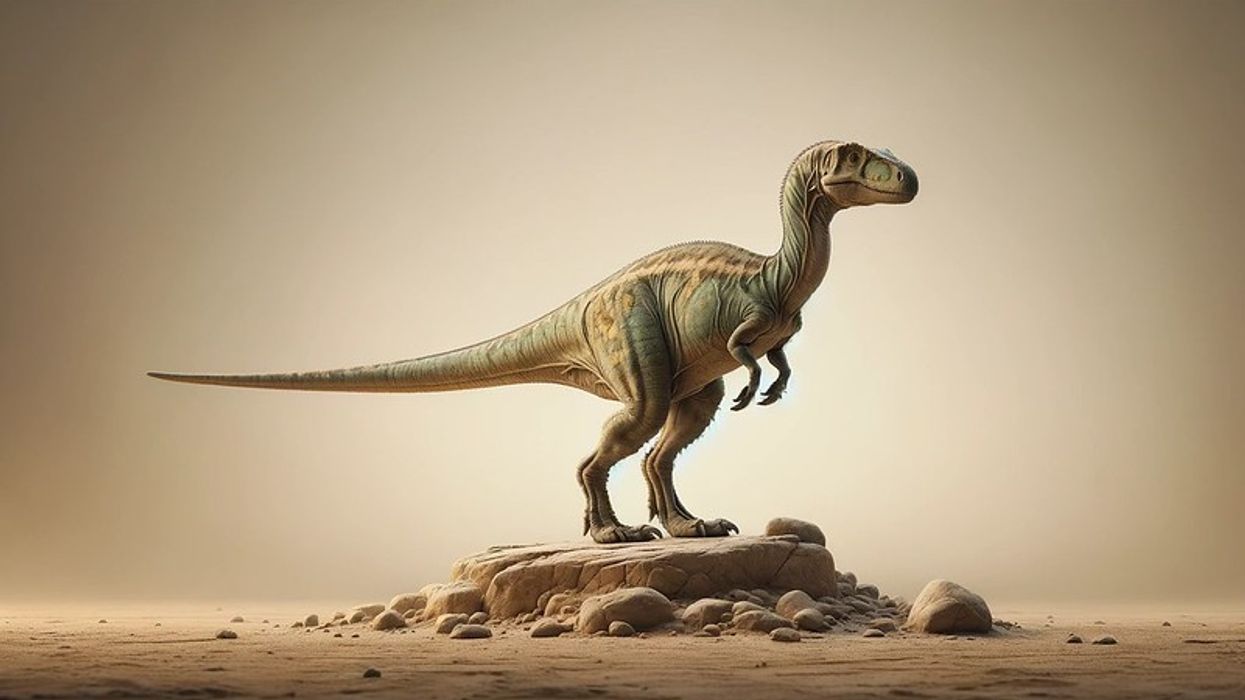Gasparinisaura is a genus consisting of an ornithopod dinosaur species that existed during the Late/Upper Cretaceous period approximately 86-71 million years ago.
This dinosaur belongs to the class Sauropsida, suborder Cerapoda, and the order Ornithischia. The name Gasparinisaura was kept in the honor of the Argentine paleontologist Dr. Zulma B. de Gasparini. This genus comprises only of one type species, Gasparinisaura cincosaltensis.
The specific name refers to Cinco Saltos city. The fossils of this species were found in Argentina near Cinco Saltos City, northwestern Rio negro Province, Patagonia. This dinosaur is believed to have inhabited woodlands throughout its range.
Gasparinisaura cincosaltensis is estimated to have ranged between the length of 2.6-5.5 ft (0.8- 1.7 m), attained a height of 0.9 ft (0.3 m), and weighed about 28.6 lb (13 kg). It had an elongated round head with large eye sockets that were located quite high.
The jaw joints of Gasparinisaura cincosaltensis were low and its forelimbs were built lightly. Gasparinisaura cincosaltensis was a herbivore and had a plant-based diet.
It did not hunt other animals but was preyed upon by huge predators that co-existed with it. It is known that these dinosaurs reproduced by laying eggs.
Interested to know more? Keep reading to discover Gasparinisaura interesting facts related to its diet, classification, fossils, size, and more!
If you enjoyed reading our Gasparinisaura facts, you must discover our Ornithomimus surprising facts and Noasaurus interesting facts!
Gasparinisaura Interesting Facts
How do you pronounce 'Gasparinisaura '?
The name 'Gasparinisaura' of this dinosaur was given by Leonardo Salgado and Rodolfo Coria in 1996 with the generic name 'gasparini' honoring the Argentine paleontologist Zulma Brandoni de Gasparini. It is pronounced as 'gas-pah-reen-ee-sore-uh'.
What type of dinosaur was a Gasparinisaura?
The Gasparinisaura (meaning 'Gasparini’s lizard') is a genus that consists of a herbivorous ornithopod dinosaur that existed during the Late Cretaceous. The dinosaur species Gasparinisaura cincosaltensis is the only species in this genus.
This dinosaur belongs to the class Sauropsida, suborder Cerapoda, and the order Ornithischia. The first fossils of the Gasparinisaura dinosaur were discovered in the Río Negro Province Province, near Cinco Saltos, in Argentina (South America).
The type species was described by Leonardo Salgado and Rodolfo Coria in 1996. They considered it to be a basal iguanodon, the clade of Euiguanodontia's most basal members.
In which geological period did the Gasparinisaura roam the earth?
The herbivorous ornithopod dinosaurs of the Gasparinisaura genus are believed to have existed during the Upper/Late Cretaceous, approximately 86-71 million years ago.
When did the Gasparinisaura become extinct?
This Late Cretaceous period dinosaur is believed to have become extinct 71 million years ago.
Where did a Gasparinisaura live?
The fossil remains of this dinosaur were found in the Rio Colorado Formation, Anacleto Member, of the Upper Cretaceous period. The discovery of these remains in Argentina, South America, suggests that it was spread across the Mesozoic world.
It is assumed to have been endemic to South America as its fossils have not been found anywhere else in the world.
What was a Gasparinisaura's habitat?
It is believed that this dinosaur dwelled in woodlands throughout its range.
Who did a Gasparinisaura live with?
It is believed that these plant-eating dinosaurs lived in herds as there were numerous fossil remains excavated from a particular area. It is assumed that living in herds protected these dinosaurs from being preyed upon by large predators that dwelled in the same ecosystem as them. Their ability to run away also helped them to protect themselves.
How long did a Gasparinisaura live?
The lifespan of this dinosaur has not yet been evaluated by paleontologists.
How did they reproduce?
It is known that these dinosaurs reproduced by laying eggs. However, their reproduction process has not yet been determined in detail.
Gasparinisaura Fun Facts
What did a Gasparinisaura look like?

The Gasparinisaura was quite a small-sized dinosaur that ranged between 2.6-5.5 ft (0.8- 1.7 m) in length, attained a height of 0.9 ft (0.3 m), and weighed approximately 28.6 lb (13 kg). It is suggested that the small-sized dinosaur, the Gasparinisaura, might have possessed feathers! The head of this dinosaur was moderately elongated and round.
It had large eye-sockets that were located quite high on its head. The jaw joints of this dinosaur, the Gasparinisaura Cincosaltensis, were low.
It had lightly built forelimbs. The skull of Gasparinisaura Cincosaltensis measured 2.7 in (7 cm) in length. The skull featured 12 large teeth in each jaw.
How many bones did a Gasparinisaura have?
It is not known how exactly many bones this dinosaur possessed. However, we do know that the fossil remains that were recovered comprised of a partial skeleton consisting of a skull and most of its vertebral column.
The bones of the tail along with those of the lower hindlimb were also discovered. The pelvis was also discovered in another specimen. Later on, the skeleton of juvenile individuals was also found.
How did they communicate?
It is not known for sure how these dinosaurs communicated. However, it is believed that the crest found in ornithopods functioned as a resonating chamber that allowed them to produce loud and deep sounds.
These calls are assumed to have helped them in warning each other about potential predators nearby. These calls could have also been used to keep their herd together or to attract a suitable partner. The crest could also have served as a visual display as it was quite odd-shaped.
How big was a Gasparinisaura?
The Gasparinisaura size was small as compared to the large predators that co-existed with it. It ranged between 2.6-5.5 ft (0.8-1.7 m) in length and is estimated to have attained a height of 0.9 ft (0.3 m).
How fast could a Gasparinisaura move?
It is believed that these dinosaurs had the ability to run away quickly so as to protect themselves from mighty predators. Their forelimbs of Gasparinisaura cincosaltensis were lightly built, but their hindlimbs were comparatively very powerful and long, possessing a long lower leg and a short thighbone. Its feet were also quite long.
How much did a Gasparinisaura weigh?
It is estimated that this dinosaur weighed about 28.6 lb (13 kg).
What were the male and female names of the species?
There are no sex-specific names assigned to the males and females of this species.
What would you call a baby Gasparinisaura?
The baby of this Late Cretaceous period dinosaur can be referred to as a hatchling or a juvenile.
What did they eat?
These dinosaurs were herbivores and had a plant-based diet. They did not prey upon other animals but were preyed upon by large predators of their ecosystem.
How aggressive were they?
These dinosaurs are assumed to have not been as aggressive as the other larger dinosaurs that co-existed with them. They did not cause any harm to any other animals.
Did you know...
The dinosaur, Anabisetia, is closely related to this South American ornithopod!
What part of the world did the Gasparinisaura live in?
The Gasaparinisaura is a small-sized ornithopod dinosaur from the Upper Cretaceous of Argentina. The fossil remains of Gasparinisaura were discovered in present-day North Patagonia, Argentina, South America.
What sounds did Gasparinisaura make?
It is not known what sound this dinosaur made. However, ornithopods possessed an oddly-shaped crest that is believed to have functioned as a resonating chamber that allowed them to produce loud and deep sounds
Here at Kidadl, we have carefully created lots of interesting family-friendly dinosaur facts for everyone to discover! For more relatable content, check out these Archaeoceratops facts and Pegomastax facts for kids.
You can even occupy yourself at home by coloring in one of our free printable Gasparinisaura coloring pages.
Main image by Nobu Tamura .
Second image by Michael B. H.









